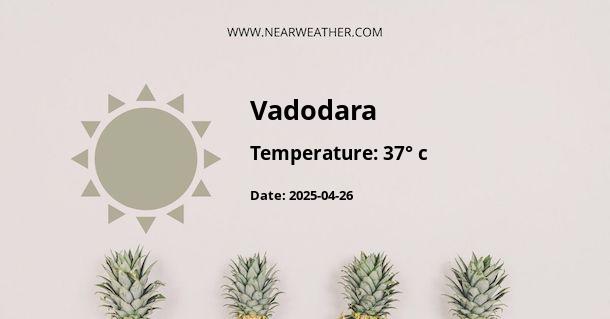Overview of Vadodara, India
Vadodara, also known as Baroda, is the third-largest city in the Indian State of Gujarat. It is known for its palaces, parks, temples, and museums. Besides its cultural and historical significance, Vadodara's climate and weather patterns play a crucial role in shaping the city's lifestyle and activities.
Climate Classification
Vadodara has a tropical savanna climate (Aw) under the Köppen climate classification. This means the city experiences moderate to high temperatures throughout the year, with a pronounced dry season and a significant wet season.
Weather Patterns Through the Year
The weather in Vadodara can be broadly divided into three main seasons: summer, monsoon, and winter.
Summer (March – June)
Summers in Vadodara are typically hot and dry, with temperatures often exceeding 40 degrees Celsius. On average, May is the hottest month of the year. Despite the intense heat, the relative humidity during this period is lower, making the heat somewhat bearable.
Monsoon (June – September)
The monsoon season in Vadodara starts from June and continues till September. The city receives substantial rainfall from the southwest monsoon winds. July is usually the wettest month, with an average rainfall of about 300 mm.
Winter (November – February)
Winter in Vadodara is mild and pleasurable. The temperature generally ranges between 15 degrees Celsius to 30 degrees Celsius. January is the coldest month of the year.
Annual Weather Statistics
| Month | Average High (°C) | Average Low (°C) | Average Rainfall (mm) |
|---|---|---|---|
| January | 29 | 15 | 1 |
| February | 32 | 17 | 1 |
| March | 36 | 21 | 1 |
| April | 39 | 25 | 1 |
| May | 41 | 27 | 4 |
| June | 37 | 27 | 93 |
| July | 33 | 26 | 300 |
| August | 32 | 25 | 235 |
| September | 34 | 24 | 121 |
| October | 36 | 22 | 23 |
| November | 33 | 18 | 7 |
| December | 30 | 15 | 2 |
Climate Impact on Lifestyle and Activities
Understanding the local climate is crucial for both residents and tourists as it directly impacts daily life and activities. The climate of Vadodara has a significant influence on its agriculture, water supply, and local festivals.
Agriculture
The monsoon season is crucial for agriculture in Vadodara. The abundant rainfall during this period is vital for the growth of crops such as rice, cotton, pulses, and sugarcane.
Water Supply
Vadodara's water supply largely depends on the monsoon rains. The city's dams and reservoirs are replenished during this period, ensuring a steady water supply throughout the year.
Local Festivals
The climate also influences the timing and celebrations of local festivals. For instance, Navratri, one of the most significant festivals in Vadodara, is celebrated in October, when the weather is pleasant.
Conclusion
In conclusion, Vadodara's climate, characterized by hot summers, rainy monsoons, and mild winters, significantly impacts the city's lifestyle and activities. Understanding these weather patterns can greatly enhance the experience of living in or visiting this vibrant city.
A - Vadodara's Latitude is 22.299999 & Longitude is 73.199997.
A - Weather in Vadodara is 37° today.
A - Climate Conditions in Vadodara shows clear sky today.
A - Humidity in Vadodara is 19% today.
A - Wind speed in Vadodara is 13 km/h, flowing at 281° wind direction. today.
